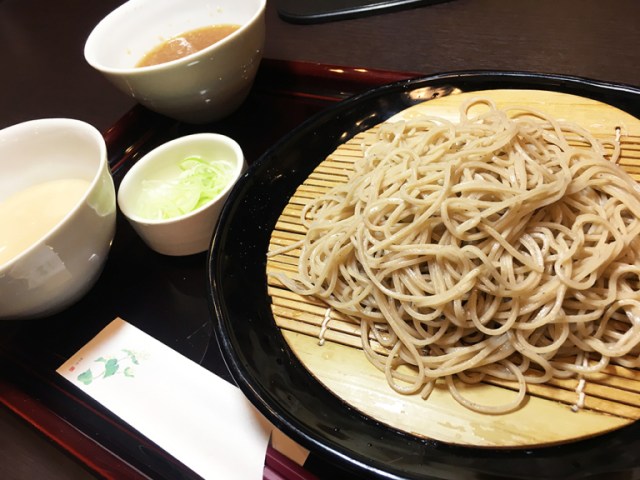
An unlikely pairing makes for delightful flavoring, and it’s vegetarian-friendly too!
Soba noodles, made of buckwheat, are a unique cuisine to Japan, but that doesn’t mean there’s only one way to eat them. Between yakisoba, kakesoba (hot soba), and zaru soba (cold soba), and between instant, fast food, home style, and Michelin quality, and with all of the different topping styles, you’re guaranteed to always be able to find a new flavor of soba wherever you go.
In fact, just last month, we tried out a completely unheard-of kind of cold soba that comes with tuna broth and is topped with maguro sashimi. The unusual flavor combination of this dish produced by the chefs at Maguro Soba really caught our attention, and when we were next in the Asakusa neighborhood looking for lunch, we found ourselves back at Maguro, hoping for another glorious new flavor exploration.
On this visit, we actually learned that Maguro Soba has special dishes that are catered towards foreign guests, since Asakusa is a pretty touristy area. So we decided to order one, and what came was a complete surprise.
The broth was white!
Normally, when eating zaru soba, you dip it into a brown and slightly translucent broth called tsuyu, which is usually made from bonito flakes, so we never expected to find a broth like this. We asked the owner, Mr. Utagawa, with whom we have been friendly since our first visit, about the broth. He said, “A lot of foreign guests are vegetarian, so we made this dish for them.”
Since bonito is a fish, and some vegetarians can’t eat fish, the two different broths that come with this vegetarian-friendly zaru soba are made of grated daikon and soy milk, respectively. We’ve eaten a kind of daikon broth before, but we’ve never seen anything with soy milk in it.
Do soy milk and soba noodles actually go together?! Looking at the bowls side by side, we were pretty dubious. Honestly, we weren’t sure if anything milky or creamy would go well with soba. It just…didn’t sound right. Was this really going to be good? Hesitantly we scooped up some noodles and dipped it in the broth…and slowly, slowly we brought it to our lips…
What? Hm? We can’t…we can’t really explain how, but somehow the soy milk becomes like a thick, creamy white sauce. It actually goes really well together with the noodles. When you dip them in, the milkiness of the soy milk gives the whole flavor a deepness and richness that’s never been seen in an ordinary bonito tsuyu.
It’s truly outstanding, in spite of not having any bonito in it at all. Furthermore, although it’s got a deep flavor, it’s not at all intense; in fact its lightness allows the mild, earthy flavors of the buckwheat noodles to come through strongly. It’s absolutely delicious! In fact we were so struck with how delicious the soy milk broth was that we almost forgot to try the daikon broth. We only had a few noodles left to eat with it, but it was really tasty too.
It goes to show that going vegetarian doesn’t mean you have to skimp on flavor. Although it may not be the most authentic flavor of Japanese soba noodles, this variety of zaru soba at least gives vegetarians a chance to try it out. Plus, if just noodles aren’t enough for you, Maguro Soba’s vegetarian menu also includes vegetable tempura that isn’t made using eggs, so you can have a full, vegetarian-friendly meal there.
It can be hard to find food in Japan if you have a special diet, and even harder to communicate those needs if you can’t speak the language. That’s why it’s great that restaurants like this, and the halal-friendly ramen shop that’s also located in Asakusa, exist in Tokyo, so that everyone can enjoy all the wonderful things that the city has to offer.
Restaurant information
Maguro Soba / まぐろそば
Address: Tokyo-to, Taito-ku, Asakusa 1-31-3
東京都台東区浅草1-31-3
Open 11 a.m.-9 p.m.
Closed Wednesdays
Website
Photos © SoraNews24

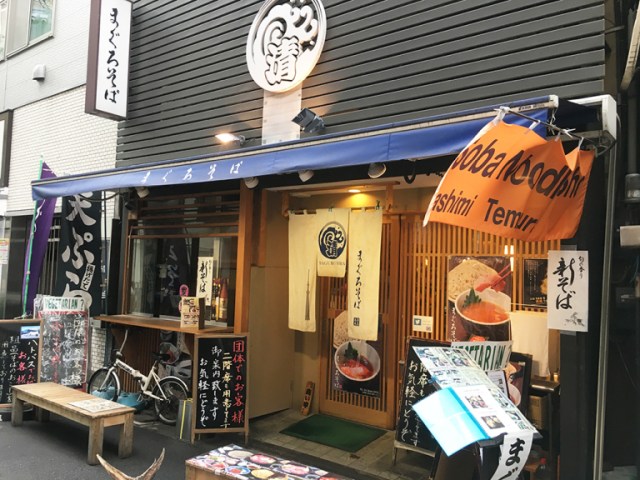
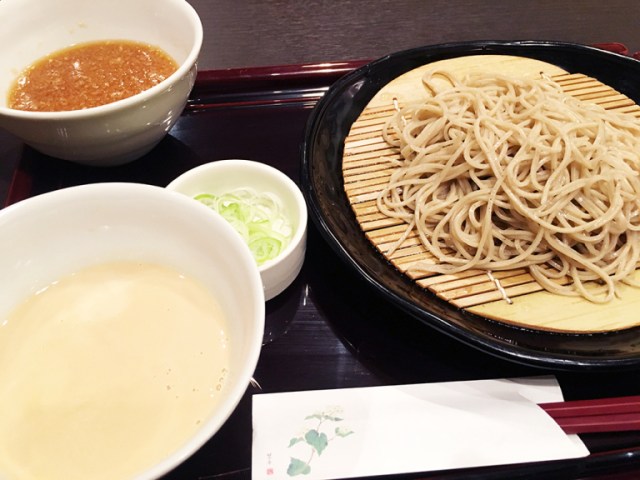
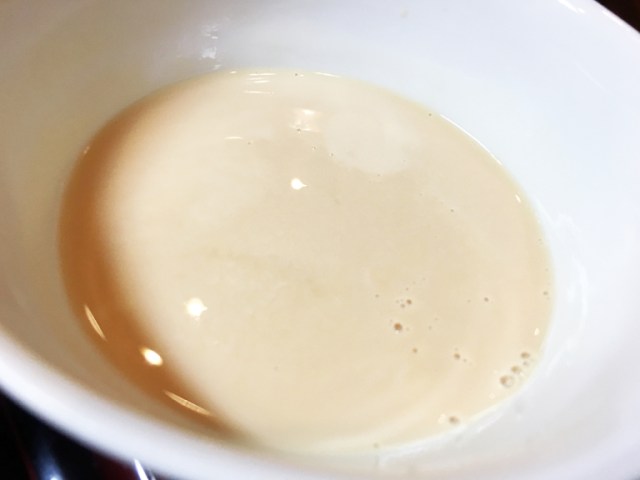

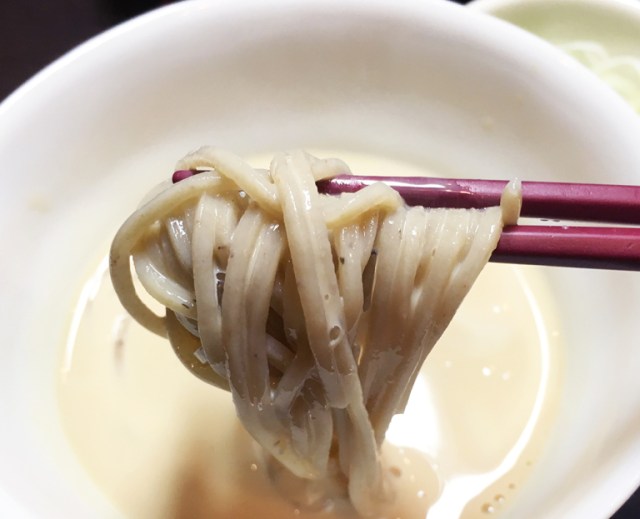
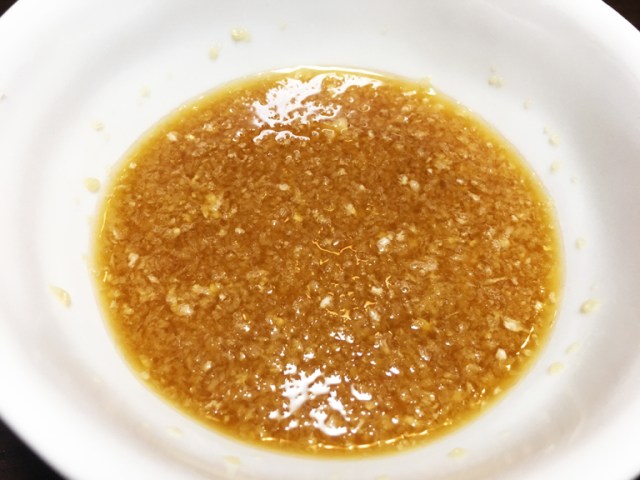

 Chilled coffee noodles for dessert are Japan’s newest summertime sweets innovation
Chilled coffee noodles for dessert are Japan’s newest summertime sweets innovation Which noodles, other than Okinawa soba, pair best with Okinawa soba broth?【Taste Test】
Which noodles, other than Okinawa soba, pair best with Okinawa soba broth?【Taste Test】 What does a family restaurant in the middle of nowhere, Hokkaido, serve? We find out
What does a family restaurant in the middle of nowhere, Hokkaido, serve? We find out Shibuya City Office serves up insanely cheap soba noodles, but are they any good?
Shibuya City Office serves up insanely cheap soba noodles, but are they any good? The top 10 most popular instant noodle brands at the start of 2021
The top 10 most popular instant noodle brands at the start of 2021 McDonald’s Japan’s new pancake pie is a taste sensation
McDonald’s Japan’s new pancake pie is a taste sensation Studio Ghibli unveils new goods that tip the hat to The Cat Returns
Studio Ghibli unveils new goods that tip the hat to The Cat Returns Starbucks at Shibuya Scramble Crossing reopens, but is it really bigger and better than before?
Starbucks at Shibuya Scramble Crossing reopens, but is it really bigger and better than before? Bad tourist manners at Mt Fuji Lawson photo spot prompts Japanese town to block view with screens
Bad tourist manners at Mt Fuji Lawson photo spot prompts Japanese town to block view with screens One of Japan’s oldest castles now lets travelers spend night on the grounds, drink in its keep
One of Japan’s oldest castles now lets travelers spend night on the grounds, drink in its keep Haku is…Chihiro’s dead brother? Studio Ghibli fans blown away by Spirited Away theory
Haku is…Chihiro’s dead brother? Studio Ghibli fans blown away by Spirited Away theory French Fries Bread in Tokyo’s Shibuya becomes a hit on social media
French Fries Bread in Tokyo’s Shibuya becomes a hit on social media All-you-can-drink deal for US$4 in Shinjuku is one of the best finds in Tokyo
All-you-can-drink deal for US$4 in Shinjuku is one of the best finds in Tokyo Two things to do, and two things not to do, when leaving a traditional Japanese inn
Two things to do, and two things not to do, when leaving a traditional Japanese inn Studio Ghibli unveils massive T-shirt collection featuring top anime movie characters
Studio Ghibli unveils massive T-shirt collection featuring top anime movie characters Foreigner’s request for help in Tokyo makes us sad for the state of society
Foreigner’s request for help in Tokyo makes us sad for the state of society Red light district sushi restaurant in Tokyo shows us just how wrong we were about it
Red light district sushi restaurant in Tokyo shows us just how wrong we were about it Japanese city loses residents’ personal data, which was on paper being transported on a windy day
Japanese city loses residents’ personal data, which was on paper being transported on a windy day McDonald’s new Happy Meals offer up cute and practical Sanrio lifestyle goods
McDonald’s new Happy Meals offer up cute and practical Sanrio lifestyle goods Japanese ramen restaurants under pressure from new yen banknotes
Japanese ramen restaurants under pressure from new yen banknotes Ghibli Park now selling “Grilled Frogs” from food cart in Valley of Witches
Ghibli Park now selling “Grilled Frogs” from food cart in Valley of Witches New definition of “Japanese whiskey” goes into effect to prevent fakes from fooling overseas buyers
New definition of “Japanese whiskey” goes into effect to prevent fakes from fooling overseas buyers Our Japanese reporter visits Costco in the U.S., finds super American and very Japanese things
Our Japanese reporter visits Costco in the U.S., finds super American and very Japanese things All-you-can-drink Starbucks and amazing views part of Tokyo’s new 170 meter-high sky lounge
All-you-can-drink Starbucks and amazing views part of Tokyo’s new 170 meter-high sky lounge More foreign tourists than ever before in history visited Japan last month
More foreign tourists than ever before in history visited Japan last month New Pokémon cakes let you eat your way through Pikachu and all the Eevee evolutions
New Pokémon cakes let you eat your way through Pikachu and all the Eevee evolutions Disney princesses get official manga makeovers for Manga Princess Cafe opening in Tokyo
Disney princesses get official manga makeovers for Manga Princess Cafe opening in Tokyo Sales of Japan’s most convenient train ticket/shopping payment cards suspended indefinitely
Sales of Japan’s most convenient train ticket/shopping payment cards suspended indefinitely Sold-out Studio Ghibli desktop humidifiers are back so Totoro can help you through the dry season
Sold-out Studio Ghibli desktop humidifiers are back so Totoro can help you through the dry season Japanese government to make first change to romanization spelling rules since the 1950s
Japanese government to make first change to romanization spelling rules since the 1950s Ghibli founders Toshio Suzuki and Hayao Miyazaki contribute to Japanese whisky Totoro label design
Ghibli founders Toshio Suzuki and Hayao Miyazaki contribute to Japanese whisky Totoro label design Doraemon found buried at sea as scene from 1993 anime becomes real life【Photos】
Doraemon found buried at sea as scene from 1993 anime becomes real life【Photos】 Tokyo’s most famous Starbucks is closed
Tokyo’s most famous Starbucks is closed One Piece characters’ nationalities revealed, but fans have mixed opinions
One Piece characters’ nationalities revealed, but fans have mixed opinions We asked a Uniqlo employee what four things we should buy and their suggestions didn’t disappoint
We asked a Uniqlo employee what four things we should buy and their suggestions didn’t disappoint We try cooking yakisoba with real Japanese buckwheat soba【SoraKitchen】
We try cooking yakisoba with real Japanese buckwheat soba【SoraKitchen】 “Hey, Japanese taxi driver, take us to the best Yaeyama soba noodles on Ishigaki Island!”
“Hey, Japanese taxi driver, take us to the best Yaeyama soba noodles on Ishigaki Island!” Japanese restaurant serves extra wide noodles next to Tokyo Station
Japanese restaurant serves extra wide noodles next to Tokyo Station What the heck is okame soba?
What the heck is okame soba? Hey, have you eaten the news? – Japanese “noodle newspaper” comes with writing on the soba
Hey, have you eaten the news? – Japanese “noodle newspaper” comes with writing on the soba We eat at the legendary Negidon, a Tokyo soba restaurant that’s only open for lunch on weekdays
We eat at the legendary Negidon, a Tokyo soba restaurant that’s only open for lunch on weekdays Wasabi and salt flavored instant soba released to help cope with summer heat
Wasabi and salt flavored instant soba released to help cope with summer heat Want some carbs with your carbs? Japanese noodle restaurant offering bread soba
Want some carbs with your carbs? Japanese noodle restaurant offering bread soba We check out Kawaichi, a crazy good soba shop in Akihabara
We check out Kawaichi, a crazy good soba shop in Akihabara Tokyo ramen restaurant’s made-to-order noodles are only the beginning of its awesomeness
Tokyo ramen restaurant’s made-to-order noodles are only the beginning of its awesomeness Why did this stand-and-eat soba noodle shop in Tokyo open in the middle of the pandemic?
Why did this stand-and-eat soba noodle shop in Tokyo open in the middle of the pandemic? We find Italian Soba at an Aomori fish market that insisted it’s perfect for the beach
We find Italian Soba at an Aomori fish market that insisted it’s perfect for the beach How to turn a classic Japanese noodle dish into Studio Ghibli’s Totoro
How to turn a classic Japanese noodle dish into Studio Ghibli’s Totoro Popcorn shrimp udon, as in noodles with popcorn and shrimp, now on the menu in Tokyo【Taste test】
Popcorn shrimp udon, as in noodles with popcorn and shrimp, now on the menu in Tokyo【Taste test】 What does vegan ramen taste like? We try Veggie Brown Rice Ramen
What does vegan ramen taste like? We try Veggie Brown Rice Ramen We visit Tokyo’s new all-plant-based cafe “Komeda Is □”
We visit Tokyo’s new all-plant-based cafe “Komeda Is □”
Leave a Reply